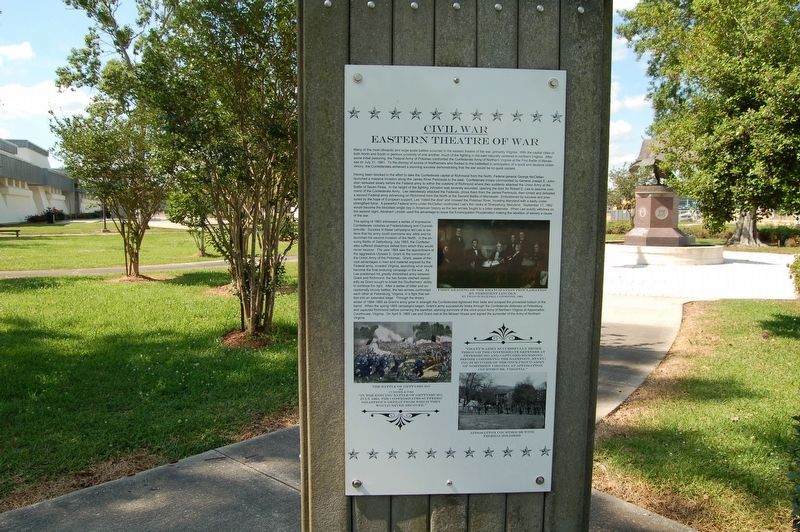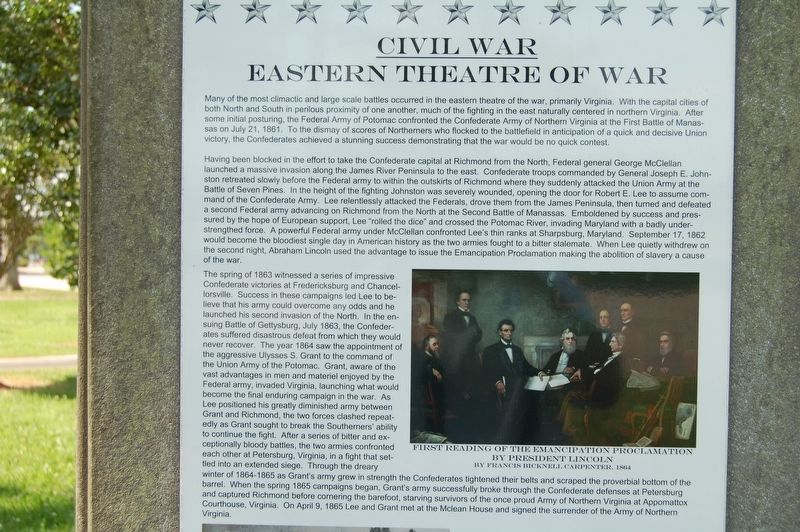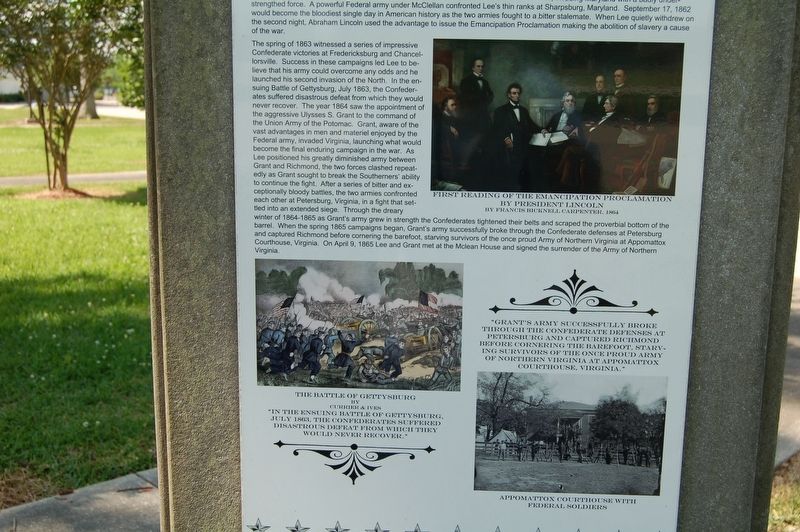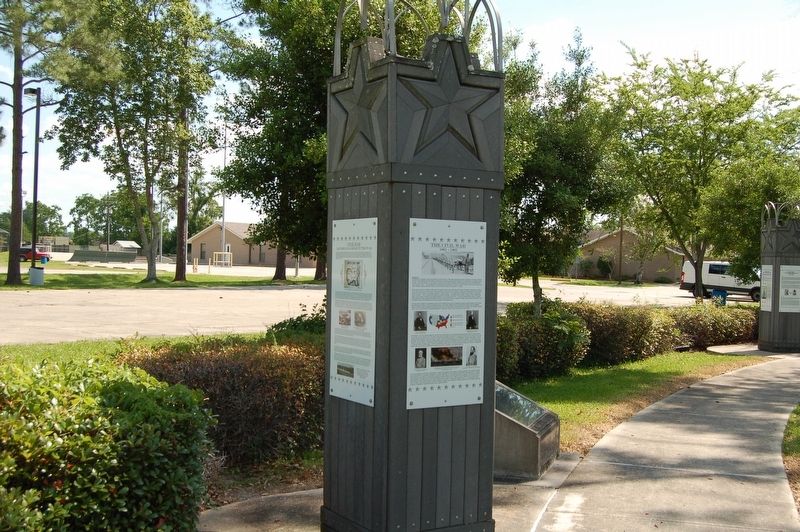Civil War
Eastern Theatre Of War
Many of the most climactic and large scale battles occurred in the eastern theatre of the war, primarily Virginia. With the capital cities of both North and South in perilous proximity of one another, much of the fighting in the east naturally centered in northern Virginia. After some initial posturing, the Federal Army of Potomac confronted the Confederate Army of Northern Virginia at the First Battle of Manassas on July 21, 1861. To the dismay of scores of Northerners who flocked to the battlefield in anticipation of a quick and decisive Union victory, the Confederates achieved a stunning success demonstrating that the war would be no quick contest.
Having been blocked in the effort to take the Confederate capital at Richmond from the North, Federal general George McClellan launched a massive invasion along the James River Peninsula to the east. Confederate troops commanded by General Joseph E. Johnston retreated slowly before the Federal army to within the outskirts of Richmond where they suddenly attacked the Union Army at the Battle of Seven Pines. In the height of the fighting Johnston was severely wounded, opening the door for Robert E. Lee to assume command of the Confederate Army. Lee relentlessly attacked the Federals, drove them from the James Peninsula, then turned and defeated a second Federal army advancing on Richmond
from the North at the Second Battle of Manassas. Emboldened by success and pressured by the hope of European support, Lee “rolled the dice" and crossed the Potomac River, invading Maryland with a badly under strengthened force. A powerful Federal army under McClellan confronted Lee's thin ranks at Sharpsburg, Maryland. September 17, 1862 would become the bloodiest single day in American history as the two armies fought to a bitter stalemate. When Lee quietly withdrew on the second night, Abraham Lincoln used the advantage to issue the Emancipation Proclamation making the abolition of slavery a cause of the war.The spring of 1863 witnessed a series of impressive Confederate victories at Fredericksburg and Chancellorsville. Success in these campaigns led Lee to believe that his army could overcome any odds and he launched his second invasion of the North. In the en- suing Battle of Gettysburg, July 1863, the Confederates suffered disastrous defeat from which they would never recover. The year 1864 saw the appointment of the aggressive Ulysses S. Grant to the command of the Union Army of the Potomac. Grant, aware of the vast advantages in men and materiel enjoyed by the Federal army, invaded Virginia, launching what would become the final enduring campaign in the war. As Lee positioned his greatly diminished army between Grant and Richmond, the two forces clashed repeatedly
as Grant sought to break the Southerners' ability to continue the fight. After a series of bitter and exceptionally bloody battles, the two armies confronted each other at Petersburg, Virginia, in a fight that settled into an extended siege. Through the dreary 1864 winter of 1864-1865 as Grant's army grew in strength the Confederates tightened their belts and scraped the proverbial bottom of the barrel. When the spring 1865 campaigns began, Grant's army successfully broke through the Confederate defenses at Petersburg and captured Richmond before cornering the barefoot, starving survivors of the once proud Army of Northern Virginia at Appomattox Courthouse, Virginia. On April 9, 1865 Lee and Grant met at the Mclean House and signed the surrender of the Army of Northern Virginia.Topics. This historical marker is listed in this topic list: War, US Civil.
Location. 30° 13.71′ N, 90° 54.8′ W. Marker is in Gonzales, Louisiana, in Ascension Parish. Marker can be reached from South Irma Boulevard, 0.3 miles East Worthey Street, on the right when traveling north. Touch for map. Marker is in this post office area: Gonzales LA 70737, United States of America. Touch for directions.
Other nearby markers. At least 8 other markers are within walking distance of this marker. A different marker also named The Civil War (here, next to this marker); a different marker also named Civil War (here, next to this marker); a different marker also named Civil War (here, next to this marker); World War I (a few steps from this marker); "The War to End War" (a few steps from this marker); A View From The Trenches: A Doughboy From Donaldsonville Writes Home (a few steps from this marker); The Freedom Fountain (a few steps from this marker); The Mexican-American War (within shouting distance of this marker). Touch for a list and map of all markers in Gonzales.
More about this marker. Located in the Gonzales Veterans Memorial Park.
Credits. This page was last revised on March 14, 2018. It was originally submitted on March 14, 2018, by Cajun Scrambler of Assumption, Louisiana. This page has been viewed 228 times since then and 16 times this year. Photos: 1, 2, 3, 4. submitted on March 14, 2018.



